Tattoos are a popular form of body art, however they can come with risks. One of these risks is keloid formation, where the tattoo can take on an unusual, raised appearance. Read on to learn more about the risks of keloid formation from tattoos and how to prevent it.
Contents
What is a Keloid?
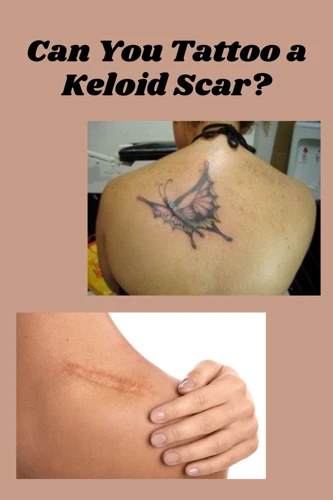
A keloid is an overgrowth of scar tissue that develops after a skin injury or wound. It is a very common problem, particularly after skin trauma such as surgery, piercing, or even a tattoo. Keloids can form anywhere on the body, but are most common on the chest, shoulders, and ears.
Keloid scars typically appear as raised, reddish-purple nodules on skin. They may become itchy, tender, or painful. If a keloid continues to grow, it may spread beyond the borders of the original wound or injury, and can become discolored.
Risks and How to Prevent Keloid After Tattoo
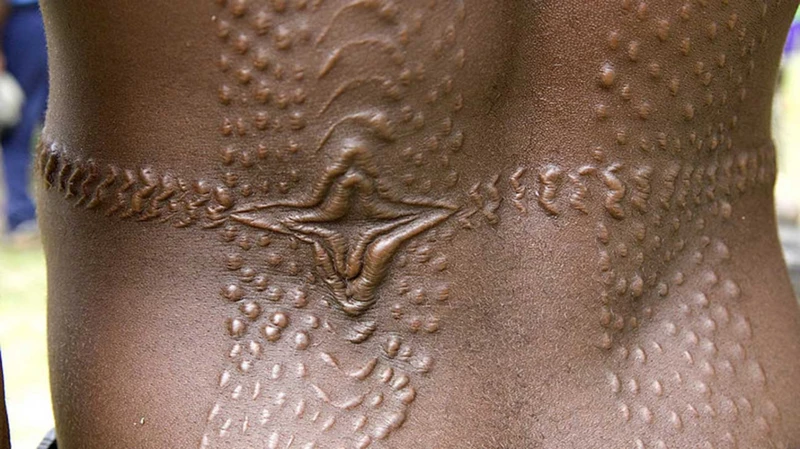
Getting a tattoo can increase your risk of developing a keloid, especially if you have a personal or family history of keloids. When getting a tattoo, it is important to choose a reputable tattoo artist and to make sure the tattoo parlor follows proper safety and sanitation procedures.
If you are concerned about developing a keloid, you may want to discuss possible alternatives with your tattoo artist, such as using a topical anesthetic to reduce discomfort during the procedure. It is also important to keep the area clean and dry after the tattoo, and to avoid picking or scratching the area.
In addition, some people may benefit from using a silicone-based scar treatment product after getting a tattoo. These products can help reduce redness, itching, and pain associated with keloid scars. However, it is important to talk to your doctor before using any scar treatments.
What Does a Keloid Look Like on a Tattoo?
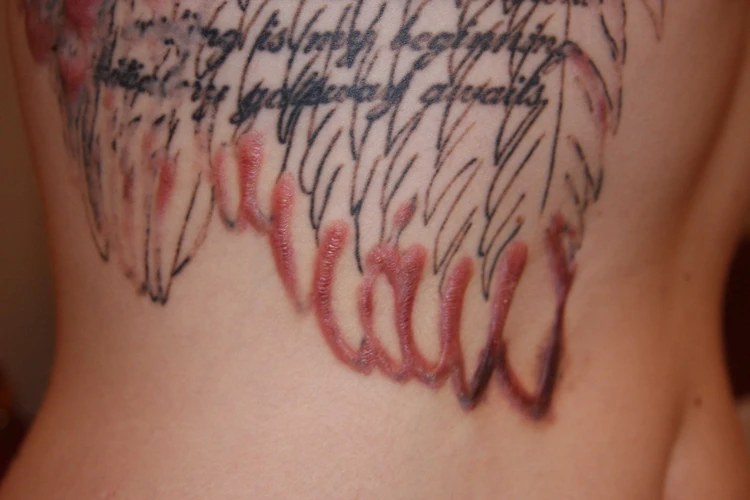
Keloids can appear on tattoos as a raised, puffy, flesh-colored or reddish mound of scar tissue. They are usually larger than the area of the original tattoo, and may feel firm or rubbery to the touch. They can range in size from a few millimeters to several inches in diameter.
| Appearance | Description |
|---|---|
| Raised | Keloids are raised above the surface of the skin. |
| Puffy | Keloids can appear swollen and puffy. |
| Flesh-Colored or Reddish | Keloids can vary from flesh-colored to reddish in color. |
| Mound of Scar Tissue | Keloids are a mound of scar tissue. |
| Larger Than Tattoo | Keloids are usually larger than the original tattoo. |
Keloids can be itchy, painful, or even form bumps that may ooze pus. If the keloid is particularly large or painful, it may need to be removed by a doctor.
Keloids are caused by an overgrowth of scar tissue, and they can occur on any area of the body including tattoos. To prevent keloids on tattoos, it is important to keep the area clean and protected, and to avoid any trauma to the skin. Additionally, it is recommended to use a high-quality tattoo ink and to choose a professional, experienced tattoo artist.
What Causes Keloids on Tattoos?
Keloids on tattoos are raised, red, and itchy scars that appear after the healing process of a tattoo. They can form anywhere on the body, including the area of the tattoo. Keloids are caused by an overproduction of collagen during the wound-healing process. When the body senses a wound, it sends an abundance of collagen to the area to heal it. This extra collagen can cause a bump or raised area on the tattoo.
Risk Factors
Certain factors can increase the risk of developing keloids on tattoos. Darker ink pigments, such as black and green, are more likely to cause keloids. People with darker skin tones, such as African Americans and Hispanics, are more likely to develop keloids on tattoos. Additionally, people with a family history of keloids are more likely to develop them.
Prevention
There are several ways to reduce the risk of developing keloids on tattoos. Avoiding darker ink pigments can help. Additionally, getting tattoos in areas where the skin is less likely to stretch, such as the shoulder or upper arm, can help reduce the risk. People with a family history of keloids should discuss the risks with their tattoo artist before getting a tattoo. Finally, keeping the area clean and moisturized during the healing process can help.
Treatment
Keloids on tattoos can be treated, although they can be difficult to remove completely. Treatments such as steroid injections, cryotherapy, and laser therapy can all be used to reduce the size of keloids. In some cases, surgery may be necessary to remove the keloid completely.
How Do You Know If Your Tattoo Will Keloid?
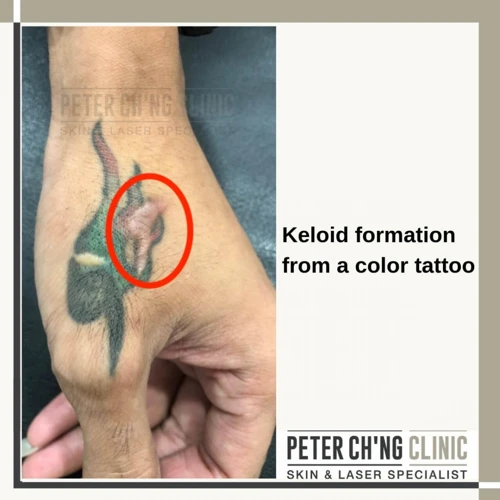
The best way to know if your tattoo will keloid is to look for signs of excessive scarring. Keloid scars are raised, thick, and tend to be darker than the surrounding skin. They usually have a smooth top and grow beyond the original tattoo outline. It’s possible to have a keloid even if the area of your skin wasn’t previously damaged, so it’s important to be aware of the risks.
To reduce the risk of a keloid forming, it’s important to take proper precautions before, during, and after getting a tattoo. Before getting a tattoo, talk to your artist about the potential for keloid scarring. They may recommend a smaller, less complicated design if you are prone to keloids.
| Sign | What to Look For |
|---|---|
| Redness | Increased redness around the area of the tattoo |
| Swelling | Swelling at the site of the tattoo |
| Raised Scar | A raised scar that is darker than the surrounding skin |
| Itchiness | Itching around the area of the tattoo |
| Pain | Pain or tenderness around the area of the tattoo |
If you notice any of the signs above, contact your artist or doctor immediately. It’s important to act quickly to reduce your risk of developing a keloid. If you already have a keloid, there are several treatment options available including steroid injections, laser treatments, and cryotherapy. It’s important to discuss these options with your doctor to determine the best course of action for you.
Remember, keloids can be prevented by taking the necessary precautions before, during, and after getting a tattoo. Talk to your artist about potential keloid scarring and be aware of the signs. With the right precautions, you can enjoy your tattoo and prevent painful keloid scars.
How to Prevent Keloid After Tattoo
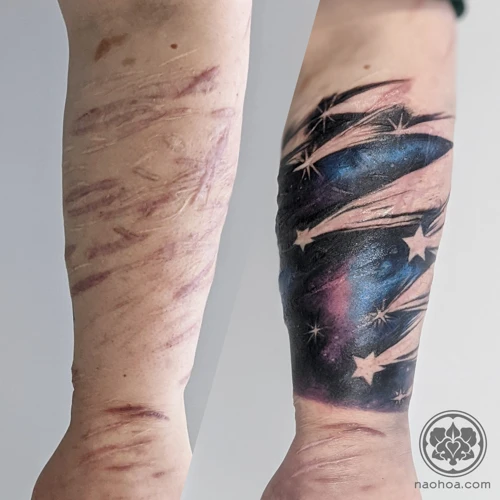
The best way to prevent keloid formation after a tattoo is to take preventive measures before getting the tattoo. First, it is important to consult with a physician to determine if you have any risk factors for keloids. Additionally, look for a qualified and experienced tattoo artist who is properly trained and knowledgeable about tattooing techniques that can minimize the risk of keloid formation.
Before getting a tattoo, it is important to make sure that the area is clean and free from any infections. It is also helpful to use a tattoo cream or balm to help keep the area moisturized and prevent the skin from drying out.
Once the tattoo is finished, it is important to take measures to ensure that the area is kept clean and moisturized. Avoiding any type of friction or tight clothing over the tattoo can help prevent the skin from becoming irritated and inflamed. Additionally, applying a moisturizer to the tattooed area can help keep it hydrated and minimize the risk of keloid formation.
If you notice any signs of keloid formation, such as a raised or bumpy area of skin, it is important to seek medical attention as soon as possible. A doctor will be able to provide treatment to minimize the risk of further keloid formation.
It is also important to know how to know if your tattoo will keloid. Signs of a possible keloid include a raised or bumpy area of skin around the tattoo, a darker or redder color of the tattoo, or a raised area of skin that is itchy or painful. If you notice any of these signs, it is important to seek medical attention right away.
How to Prevent Keloids on Tattoos
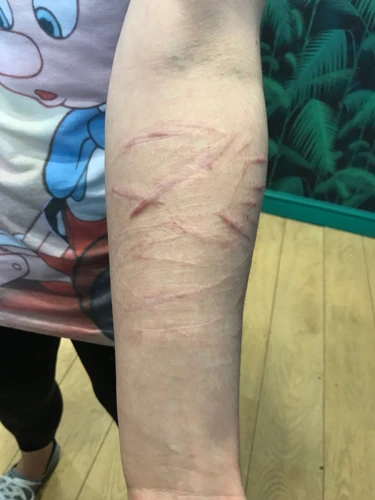
- Before getting a tattoo, consult with a licensed professional to determine if you are at risk of developing keloids.
- Choose a tattoo artist who is experienced in tattooing and has a good reputation.
- Carefully select the area of your body to get your tattoo. Some areas are more prone to keloid formation than others, such as the chest, shoulders, and upper arms.
- Make sure the tattoo artist uses proper sterilization techniques and fresh needles.
- Do not tattoo over a keloid. Doing so can cause the keloid to become bigger, darker, and more itchy.
- Choose a tattoo design that is smaller and less intricate.
- Be sure to follow all instructions given by the tattoo artist, including keeping the tattoo area clean and moisturized.
- If you experience any signs of infection or inflammation, contact your tattoo artist or doctor right away.
How to Get Rid of Tattoo Keloids
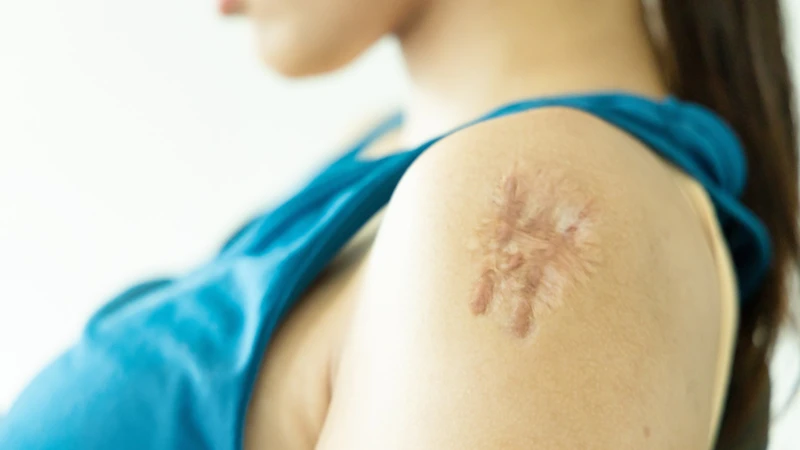
| Treatment | Overview |
|---|---|
| Cryosurgery | Freezing the keloid with liquid nitrogen. |
| Corticosteroid injections | Injecting steroids to reduce inflammation. |
| Laser treatments | Removing the keloid with a carbon dioxide laser. |
| Surgery | Removing the keloid with a scalpel. |
| Radiation therapy | Using radiation to shrink the keloid. |
| Pressure dressings | Wrapping the keloid with a bandage to reduce swelling. |
Treatment for tattoo keloids depends on the size and location of the keloid. Cryosurgery, corticosteroid injections, laser treatments, surgery, radiation therapy, and pressure dressings are some of the most common methods used to get rid of tattoo keloids.
Cryosurgery involves freezing the keloid with liquid nitrogen. This treatment can help reduce the size of the keloid, but it can also cause scarring.
Corticosteroid injections are used to reduce inflammation. They can be used to shrink the keloid and reduce itching or pain.
Laser treatments can be used to remove the keloid with a carbon dioxide laser. This treatment can help reduce the size of the keloid, but it can also cause scarring.
Surgery is another option to remove the keloid with a scalpel. This treatment can be effective, but it can also cause scarring.
Radiation therapy is the use of radiation to shrink the keloid. This treatment can help reduce the size of the keloid, but it can also cause scarring.
Pressure dressings involve wrapping the keloid with a bandage to reduce swelling. This treatment can help reduce the size of the keloid, but it can also cause scarring.
What Happens If You Tattoo Over a Keloid?
Tattooing over a keloid can have harmful effects on the skin and should be avoided. Keloids are raised areas of scar tissue that form after a wound or trauma. Tattooing can cause the keloid to become aggravated, leading to further inflammation and potential scarring.
- Pain: Tattooing over a keloid can be extremely painful, as the needle is piercing the raised area of the skin.
- Infection: Tattooing over a keloid can increase the risk of infection due to bacteria that may be present in the area.
- Scarring: Tattooing over a keloid can cause the existing keloid to become larger or more raised.
- Discoloration: Tattooing over a keloid can cause a discoloration of the tattoo, which can be difficult to remove.
It is important to take precautions to prevent keloid formation, such as avoiding trauma to the area, using a topical steroid cream during healing, and choosing a reputable tattoo artist who knows how to work with keloid-prone skin. It is also important to understand the risks of tattooing over a keloid before attempting to do so.
Frequently Asked Questions
What is a Keloid Scar?
A keloid scar is a raised, lumpy, overgrown scar that develops when the body produces an excessive amount of collagen during the healing process. It usually appears as a raised, purplish-red growth that can be larger than the original wound. Keloid scars are often itchy, painful to the touch, and can cause discoloration and texture changes on the skin. They can also be difficult to treat, so it is important to take preventative measures when getting a tattoo to avoid developing a keloid scar.
What is the Most Common Cause of Keloid Scarring?
The most common cause of keloid scarring is trauma to the skin, such as surgery, cuts, piercings, burns, and acne. It can also be caused by certain medical conditions and skin infections. People with a history of keloid formation are at higher risk of developing them again.
Are there any treatments available for keloid scarring?
Yes. Treatments for keloid scarring include:
- Steroid injections
- Cryotherapy
- Surgery
- Pressure dressings
- Laser treatments
- Radiation therapy
- Topical treatment
Each of these treatments has its pros and cons. Steroid injections are typically used to reduce the size and appearance of the keloid, while cryotherapy involves freezing the keloid with liquid nitrogen. Surgery is an option for larger keloids. Pressure dressings may also be used to flatten the keloid. Laser treatments can be used to reduce the redness and discoloration of the keloid. Radiation therapy is used to reduce the size of the keloid. Topical treatments such as creams, gels, and lotions can be used to reduce the appearance of the keloid.
What are the risks of getting a tattoo with a keloid scar?
Getting a tattoo with keloid scarring can lead to many risks, including: the area of the scar may become red, swollen, and itchy; the tattoo may not heal properly; the area may become infected; and the scar may become raised and hard. Additionally, there is a risk of further scarring, as the area may be more prone to developing keloids.
How can I reduce my risk of developing a keloid scar after a tattoo?
1. Choose a reputable tattoo artist: Choose a tattoo artist with a good reputation and a clean, sterile environment. Make sure the artist is properly trained and certified.
2. Select small tattoos: Large tattoos are more likely to cause keloid scarring. Consider getting smaller tattoos and avoiding areas of the body with thin skin.
3. Use topical analgesia: Applying a topical anesthetic prior to getting a tattoo can help reduce the risk of keloid scarring.
4. Keep the tattoo clean: It is important to keep the tattoo clean and dry to reduce the risk of infection. Follow the instructions provided by your tattoo artist on the best way to care for your tattoo.
5. Avoid sun exposure: Sun exposure can damage the skin and make it more prone to developing keloid scarring. Apply sunscreen to the tattooed area when going outside.
6. Consider laser tattoo removal: Laser tattoo removal is an option for individuals who develop keloid scarring after getting a tattoo. Talk to your doctor about the potential risks and benefits of this procedure.
Conclusion
Keloid scarring is a serious and potentially disfiguring side effect of getting a tattoo. To avoid this, take extra care with the aftercare process and discuss any potential risks with a professional before getting inked. If you already have a tattoo and see signs of keloiding, consult a physician to determine the best treatment method for you.